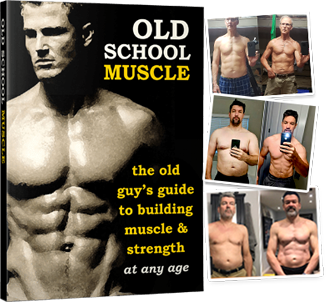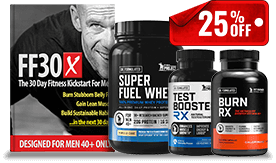A lot of men are looking to get that ripped muscular beach body. But with summer fast approaching, just how much muscle can you gain in a month?
Building muscle and getting in shape takes time, discipline, and intense motivation.
That's often easier said than done!
But with some of these top exercise and nutrition tips, you will be well on your way.
How much muscle can you gain in a month? Read on to find out!
Factors for Muscle Growth
Everyone is going to be a little different in their ability to put on muscle.
Some of these things are totally in your control, like your workout routine and nutrition intake.
Other aspects, like your genetics and age, are out of your control.
However, you should be aware of how these impact how much muscle you can gain in a month.
Age
As men age, testosterone levels decrease.
This leads to a decline in metabolism and skeletal muscle mass.
Luckily, engaging in exercise will help boost these levels.
Genetics
Hormone levels, muscle length, and bone structure all play a role in the amount of muscle you'll be able to build over time, whether that be a month or a lifetime.
For some people, the process might be a little slower than it is for others, but with a strong work ethic, anyone can achieve amazing strength gains.
Nutrition
The composition of foods you eat will play a huge role in your ability to gain muscle mass.
Protein, carbohydrates, and healthy fats will help stimulate muscle growth when eaten in the correct amounts and at the right times.
Resistance Training
This is pretty obvious, but increasing muscle mass requires that you lift heavy weights.
But just like nutrition, the types of exercise and the timing of your workouts will play a big role in determining how fast you will get those ripped muscles.
How Much Muscle Can You Gain In a Month?
Because of these different factors that impact muscle growth, the amount of muscle growth will vary between individuals.
However, on average men can expect to build between 0.25 and 0.5 pounds of muscle per week, or about one to two pounds per month.
Of course, this doesn’t continue at this pace indefinitely.
As you get your body into shape, the amount of muscle you can build will develop at a slower pace.
Build Muscle Early On
When you first start working out, your body will respond to your workouts more quickly.
This means, in the beginning, you can build muscle at a higher rate than those that have been bodybuilding for years.
Physiologic studies reveal that resistance exercise leads to adaptations in skeletal muscle that result in increased muscle size and changes in contractility even after a single episode of exercise.
This is great news when you're just starting out because the instantaneous results can help keep you motivated to continue working out.
It's important to be aware, however, that once your body's begun to adjust to your workout routine, it will become harder to gain muscle mass, which means the process slows down as you bulk up.
Try not to get discouraged and instead look at these tips to maximize your muscle growth.
Top Tips For Building Muscle Mass
Weight Training Is A Must
Resistance exercise stimulates hormones and growth factors that lead to skeletal muscle hypertrophy.
This leads to an increase in the size of your muscles and gives your body that ripped, built physique.
You have to incorporate resistance training with heavy weights to build muscle mass.
If you are just starting out, begin with a light weight and gradually work your way up each week.
This will help you avoid injury as you progressively get stronger.
You should include full body and compound exercises to target multiple large muscle groups at once.
This overall focus will get you looking great while simultaneously making you stronger.
Lift Heavier Weights With Fewer Reps
Aim for six to eight reps each set, doing three to four sets of each exercise.
This will allow you to use heavier weights so that you can really work on muscle hypertrophy.
While you can do lighter weights with higher reps to build muscle, studies have shown that using heavier weights is superior for maximizing strength adaptations.
Plus, if you are doing hundreds of reps with a lower weight, you can actually increase your risk of injury due to overuse injuries and repetitive strain.
Instead, focus on slow movements with proper form throughout the exercises.
Train Each Muscle Group At Least 2-3 Times a Week
To gain muscle as fast as possible, research suggests that you should train each muscle 2-3 times a week.
If you have an open schedule, you may be able to split this up and work specific body parts each day.
For example, Monday could be back and biceps day, Tuesday is chest day, and so on.
If you are like most men, you are pretty busy and may only have a few days that you can devote to formal exercise.
This may mean doing two or three full-body workouts a week to hit every muscle group.
And full-body workouts have shown to be quite effective in building lean muscle mass when done three times weekly.
A study in the Journal of Strength and Conditioning Research found that a training frequency of three days per week produced superior results compared to once a week.
Proper Nutrition To Maximize Muscle Growth
It is important to choose the right types of food, along with the timing of when you consume these nutrients.
Protein is the building block for muscle growth, so you want to include lean protein sources into your diet throughout the day and following your strength training workouts.
Protein is a macronutrient that not only builds muscle but also spares muscle mass while you are working out.
The exact amount of protein you should consume will depend on your specific goals and current weight.
A recent meta-analysis found that muscle-building gains seem to top out at about 1.6 grams per kilogram of body weight.
The authors of this study noted, however, that for those looking to maximize muscle-building gains this number could be increased all the way up to 2.2 grams per kilogram, or about one gram per pound of body weight.
Here’s A Free Weight Loss Meal Plan For Busy Men 40+
Discover exactly what to eat for breakfast, lunch, and dinner to lose belly fat & feel energized 24/7 without hard dieting...
What about carbohydrates?
Contrary to some popular fad diets, carbs are not the enemy.
Actually, carbohydrates are essential to gain muscle, especially on training days.
Studies have shown that weight training exercise with carbohydrate ingestion results in significantly greater gains in both type I and type II muscle fibers than in weight training exercise alone.
This means that after a high-intensity strength training workout you should consume both protein and carbohydrates to maximize your muscle growth potential.
Your calories should come from lean protein sources, such as chicken, lean beef, or fish.
As far as carbs and fat intake, you need to limit processed foods such as those high in sugars and simple starches.
To help get you started, check out the free 1-Day Meal Plan from the Fit Father Project.
This is a great introduction to help you plan out your nutrition for the day.
Eat Regularly
Studies have found that spreading your calorie intake out over the course of the day can help you gain muscle and maintain a healthy weight.
So, instead of eating two or three big meals, try to spread this out into five or six smaller meals throughout the day.
Research has shown that by doing this you can lose weight while reducing the loss of lean body mass.
And the type of food you eat throughout the day is also important.
You want to make sure that you are also specifically spreading out your protein intake over the course of the day.
Eating a moderate amount of protein at each meal stimulates muscle protein synthesis more effectively than eating more protein at one meal.
Big Muscle Gains in the First Month and Beyond
While building muscle quickly is a great goal, it is important to remember that these strength gains will continue far into the future.
And you can’t expect to reach your full potential in only 30 days!
These tips and tricks will help you jumpstart your fitness so that you can start on your journey to building a strong looking and healthy body.
And if you are looking for specific workouts, the Fit Father Project offers some great programs, like Old School Muscle, that are specifically tailored for men looking to get a ripped, chiseled physique.
So don’t let another day get away from you! Get started today and discover just how much muscle you can gain in the next month.
Writer, The Fit Father Project Holly is board-certified in nephrology and internal medicine, has a bachelor’s degree in dietetics, and is a certified personal trainer with NASM-PES certification. Holly is a keen runner, triathlete, and fitness and nutrition enthusiast. She has completed four full ironmans, twelve marathons, countless half ironmans, Olympic distance triathlons, half marathons, and numerous other road races. Holly joined the Fit Father Project in May 2019 as a regular writer, contributing articles on health, wellness, exercise, and nutrition. This proven "Old School Muscle Program For Guys 40+" combines the “old school” bodybuilding secrets with the “new school” science… to produce muscle & strength building results fast. Only for guys 40+ who want to build muscle. If you're frustrated with stubborn belly fat, failed diets, and time-consuming workouts, this is the answer you’ve been looking for…Holly Smith, M.D., B.S. - Dietetics, NASM-PES Certified Trainer
Here’s How Busy Guys 40+ Are Building Age-Defying Muscle And Strength… Working Out Just 3 Hours Per Week...
See the Old School Muscle (OSM) Program overview here. You’ll discover how this proven program has helped thousands of guys 40+ pack onage-defying muscle and strength – the smart & sustainable way. »
*Please know that weight loss results & health changes/improvements vary from individual to individual; you may not achieve similar results. Always consult with your doctor before making health decisions. This is not medical advice – simply very well-researched info on how much muscle can you gain in a month.











